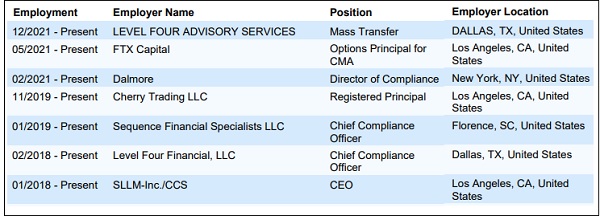By Pam Martens and Russ Martens: December 16, 2022 ~
Over the past week Wall Street On Parade has reached out to a number of individuals connected to FTX Capital Markets, the stock trading platform and SEC-registered brokerage firm that was majority owned by the indicted crypto kingpin, Sam Bankman-Fried. We’ve received two answers to our questions: Either, “I can’t talk about it” or “no comment.” Regulators have been just as tight-lipped. When we emailed one of the lawyers handling the bankruptcy process for FTX, James Bromley of Sullivan & Cromwell, the response came back from a crisis management/public relations firm, Joelle Frank. Their response was “decline to comment.”
Bankman-Fried’s ability to enter the regulated world of stock trading in the U.S. while, according to Justice Department prosecutors, he was operating a vast fraud, raises red flags about what other crypto firms may be doing or contemplating.
Despite all of the stonewalling, Wall Street On Parade has been able to significantly pull back the curtain at FTX Capital Markets. Here’s what we’ve discovered thus far.
The Wall Street self-regulator, FINRA, has documents on file showing that Sam Bankman-Fried is the indirect owner of 50 to 74 percent of FTX Capital Markets, which was purchased outright by an FTX related firm, West Realm Shires.
Despite the fact that the bankruptcy handlers for FTX are supposed to be maximizing value for the defrauded customers and investors, this brokerage firm has “ceased doing business” as of November 30 according to FINRA, just 19 days after the bankruptcy filing, and despite the fact that it was not part of the bankruptcy filing.
FINRA states that FTX Capital Markets had two primary business lines: “retailing corporate equity securities over-the-counter” and “arranging for transactions in listed securities by exchange member.” Bankman-Fried bought this brokerage firm, previously called RJL Capital, in August of last year. It had been in operation since 2011. The price he paid is unknown at this time.
In the declaration that the newly appointed FTX CEO, John Ray, filed with the bankruptcy court on November 17, he stated that “Based on the information that I have reviewed at this time” both FTX Capital Markets and an affiliated company, Embed Clearing LLC, are “solvent.” Neither firm was part of the bankruptcy petition.
If FTX Capital Markets was solvent, why wasn’t it sold quickly so that customer accounts could move easily to another SEC-registered brokerage firm, as is typically the case? If FTX Capital Markets was insolvent and Bankman-Fried used it also as his personal piggy bank, why wasn’t this mentioned in the SEC complaint filed against Bankman-Fried or the indictment filed by the Justice Department?
According to the FTX Capital Markets customer agreement, Embed Clearing was the entity that would execute the stock trades for customers; clear the trades; and custody the securities for the customers. Embed Clearing and its parent, Embed Financial Technologies, Inc., were also not part of the bankruptcy filing. According to a motion filed just yesterday in bankruptcy court, the court is being asked to authorize a quick sale of Embed Clearing and its parent. Notably, those in charge of the bankruptcy want to offer Embed for sale “free and clear of liens, claims, interests and encumbrances.”
A notice has been posted on the Embed Clearing website advising FTX Capital Markets’ customers as to how they can gain access to their account records. It reads in part:
“The Account Recovery Portal will let you:
“View current stock and cash balances
“Enter sell orders during market hours to dispose of current holdings at market prices
“Create a funding source to securely disburse funds to your requested bank account
“Retrieve account document such as statements, trade confirmations, and tax forms
“View transaction history*
“We appreciate your prompt action.
“The Embed Clearing Team
*For FTXCM customers: Your transaction history will include the deposits and withdrawals of cash that were settled automatically between your FTX US fiat balance and your brokerage account. Note that portfolio values are calculated using the prior trading day closing price.”
Based on this language, it suggests that only closing “sell” orders are being allowed and continued trading in the account is not being allowed.
Embed Clearing is also an SEC-registered broker-dealer and a member of the Securities Investor Protection Corporation (SIPC), the organization that in case of a brokerage firm failure protects securities in the account up to $500,000, including up to $250,000 protection for cash that is held in the account for the purpose of trading securities. If these Embed Clearing/FTX Capital Markets customer accounts are being processed as a SIPC liquidation, no regulator is willing to discuss it.
According to the FTX Capital Markets customer agreement, cash in the account was to be held by an unnamed, federally-insured bank. The most recent audited financial statement for the period ending March 31 for FTX Capital Markets states this:
“The Company’s cash is held at one financial institution which is insured by the Federal Deposit Insurance Corporation and at times may exceed federally insured limits. The Company has not experienced losses in such accounts and believes it is not subject to any significant credit risk on cash.”
FTX Capital Markets does not appear to have employed many licensed brokers or staff. The audited financial statement shows that the lease on its headquarters was only costing “$722 per month.” That will get you the office space the size of a large closet in lower Manhattan. (At the time of the audit the firm was located on Broad Street in the financial district in lower Manhattan.)
We called the current phone number listed by FINRA for FTX Capital Markets on multiple occasions this week. No one answers the phone and there is no voice message regarding whom to call to retrieve the assets in your account. Even more bizarre, the phone number that FINRA lists for the firm is the same phone number for a cricket company called DreamCricket. The man FINRA lists as the President of FTX Capital Markets, Venu Palaparthi, has a Twitter page listing himself as “Opening Batsman for DreamCricket.com.” Palaparthi’s LinkedIn profile shows him as Founder of DreamCricket.
Palaparthi’s LinkedIn profile indicates that he is a Fellow at the Center for Financial Markets and Policy at Georgetown University McDonough School of Business. We attempted to reach him there via email yesterday. The Center advised he is no longer affiliated with the Center.
While Palaparthi’s LinkedIn page does not show him employed at FTX Capital Markets, FINRA shows him registered at FTX Capital Markets since May 18, 2022 through the present. FINRA files are typically kept up-to-date with little more than a few days lag. We attempted to reach Palaparthi through multiple channels but have yet to receive a return email or phone call.
Adding to the bizarre nature of this firm, one licensed broker who FINRA lists as currently employed at FTX Capital Markets is Stacey Lynn Lavender (a/k/a Stacey Lynn Lavender-Mayes; a/k/a Stacey Lynn Mayes). FINRA shows Lavender simultaneously working at seven different firms. This includes serving as Chief Compliance Officer simultaneously at two firms: Sequence Financial Specialists LLC in Florence, South Carolina and Level Four Financial LLC in Dallas, Texas. Lavender is also listed as a Director of Compliance at Dalmore in New York City; as the CEO at a firm called SLLM-Inc./CCS in Los Angeles; as a Registered Principal at Cherry Trading in Los Angeles; and as an Options Principal at FTX Capital Markets.
FINRA records indicate that both Cherry Trading and FTX Capital Markets show recent requests to have SEC terminate their registration as a broker dealer as well as requests to terminate their state licenses. FINRA also shows that Cherry Trading is majority owned by an individual named Seiji Kawajiri through a company called SK World Group 1.
Anyone who has ever held a securities license through a major retail brokerage firm, such as Merrill Lynch, Morgan Stanley or Wells Fargo, knows that one has to get special permission to engage in any employment outside of your brokerage firm. It is highly discouraged because it can lead to conflicts of interest and an inability for your firm to monitor these outside activities. The possibility that someone would be allowed to work in the critical position of Chief Compliance Officer and Director of Compliance simultaneously at three firms while functioning as a CEO of another company, while finding time to be an options principal at a Sam Bankman-Fried operation, is beyond bizarre.
Lavender’s LinkedIn profile shows her working “full time” at Level Four Financial. Attempts to reach her by phone, in order to clarify the situation, failed. An email to her superior at Level Four Financial, inquiring if she is still employed there as Chief Compliance Officer, has yet to elicit a response.
Clearly, the American people still have very limited visibility on what Sam Bankman-Fried was up to in U.S. markets.
Related Articles:
Big Law Firm, Sullivan & Cromwell, Did Significant Legal Work for Bankrupt Crypto Exchange, FTX



